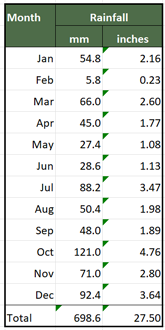There’s not been much to report weather wise over the last week. It’s remained mostly mild for January although we did have a few flakes of snow at times on Tuesday morning. We’ve had just enough rain to prevent the allotment from drying out so gardening activities remain on hold.
 |
| Temperature & Rainfall Records January 2020 |
I’ve been thinking for some time now about doing a blog post covering weather extremes. In the UK we are well known for talking endlessly about the weather, especially the extremes of weather we get. The thing is though, we don’t ever get any real extremes of weather. We live in a Maritime temperate weather climate which means the weather never gets really hot nor does it get really cold. These facts become clear after reading other people's blogs and watching YouTube channels from around the world.
I’ve been thinking about the best way to explain this and I think I’ve found just the table to show it. My Davis weather station has software to cater for all types of climates around the world. One table in particular summarises the extremes of temperature throughout the year. This summary table for 2019 is shown below.
The four columns outlined with a red box are an indication of extremes of temperature. It might not be all that obvious what each column indicates. The first column shows the number of days in the year that the temperature exceeds 32°C or 90°F. The second column indicates the number of days each year where the highest temperature during the day never gets above 0°C or 32°F. The third column indicates the number of days where the temperature falls below 0° C or 32° F at sometime during the day and finally the fourth column includes days where the temperature falls below -18°C or 0°F.
In 2019 we had one day where the temperature exceeded 32°C (90°F) and one day where the temperature never got above 0°C (32°F) all day. We had 35 days where the temperature fell below 0°C (32°F) but no days at all where the temperature got down to -18°C or 0°F.
Taking into account our climate I think that columns one, two and four record extremes of high or low temperatures. This is certainly true for where we live in our Maritime temperate climate. I’ve looked through the summary tables from 2010 to 2019 to produce the table below.
 |
| Extreme Temperature Record Summary 2010 to 2020 |





























Now that's a challenge! I'm having difficulty with the temperature conversions. Let's say that 32 C is equal to 90 F and -18 C is equal to 1 F. That gives 88 or nearly 90 F degrees difference in one year. So you are asking how many people (or places?) have a range of 90 degrees in a year? Game's on.
ReplyDeleteI've had a quick check on Weather Underground and generally I think there will be states such as Wyoming where they manage to have both high and low extremes. Can't imagine it personally.
DeleteFound so far from Wikipedia: On July 25, 1988, Verkhoyansk (Russia) recorded a temperature of +37.3 °C (99.1 °F), yielding a temperature range of 105 °C (189 °F) based on reliable records, which is the greatest temperature range in the world.
DeleteOddly weather stations in Russia don't seem to show any details other than the current temperatures. Don't think anybody from Verkhoyansk will read my blog. Gardening must be a bit tricky in winter.
Delete